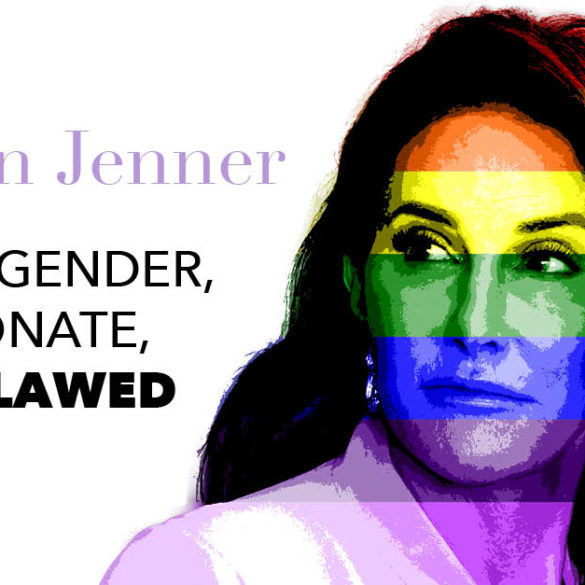Caitlyn Jenner made her introduction to the world on the cover of Vanity Fair this past June. Since then, she has received the Arthur Ashe Courage Award, was named one of Glamour Magazine’s Women of the Year, and broke the Guinness Book of World Record’s fastest time to one million Twitter followers. But Caitlyn’s coming out party has not been everything the LGBT+ community had hoped it would be.
In addition to all of her shining accolades, Caitlyn has had a number of public appearances in the last several months that have damaged her reputation with the community, of which she has only recently been deemed as an advocate. Caitlyn described herself as a traditionalist when it came to the issue of gay marriage during her interview with Ellen Degeneres in September. Additionally, Caitlyn has received backlash for her seemingly flippant opinion of the popular Halloween costume modeled after her Vanity Fair cover. And not least of all, much criticism has been directed toward Caitlyn through social media for a perceived lack of appreciation and understanding of the privilege she has as a white, rich, and famous trans person.
Lauren Hurst, a student at Ball State University and active member of the university’s LGBT+ community Spectrum, said that many trans people live in a different reality than Caitlyn. According to the National Center for Transgender Equality, trans people have much higher rates of poverty, gender and racial bias, and suicide attempts prompted by poverty, harassment, and sexual assault.
“It’s a hard pill to swallow,” Lauren said. “[The LGBTQ+ community] is angry because she’s living the life. Somebody famous comes out, but then we have all this negative stuff.”
Lauren identifies as lesbian, and feels that she dealt with a similar identity crisis that all LGBTQ+ people go through, including Caitlyn. But the difference, Lauren said, is that she did not have the same resources on her road to self-discovery. She turned to IndianaYouthGroup.org for resources to learn about her sexuality. Though gender identity and sexuality are two separate concepts within the LGBTQ+ community, Caitlyn’s ambivalence toward gay marriage has created a rift within the LGBTQ+ community.
“Everyone’s perceptions of gender and sexuality are different,” Lauren said. “But Caitlyn is still on the fence, and that takes away from the LGBT+ community.”
As Caitlyn had stated herself during an interview with Ellen DeGeneres, the culture she grew up in may have some affect on her traditionalist views. According to a social media poll conducted by Stonewall in 2010, the age at which individuals publicly come out as gay, lesbian, or bisexual is decreasing. Those 60 years and older reported an average coming out age of 37. Those in their 30s reported an average coming out age of 21. And the majority of the Millennial generation, 18-24-year-olds, reported an average age of 17.
Kylie Kuehl, a senior Ball State student, calls Caitlyn’s hesitance in comments about sexuality and gay marriage “fronting.” Kylie learned about fronting both in her personal life and in a few gender identity classes she had taken at Ball State. She states that fronting is a defense mechanism individuals use when they are coming out and not fully ready to accept themselves.
Kylie identifies as a genderfluid person, which means that she does not believe that her gender or sexuality falls in any one category on the gender identity or sexuality spectrum. She understands the confusing process one goes through when identifying one’s own desires and identity. Though Kylie’s friends and family were very supportive during her journey, she reported that the path to her true identity didn’t really open up until college.
“Identity is a process that goes on through your entire life,” Kylie said. “Caitlyn Jenner is still finding herself.”
Both Lauren and Kylie think that Laverne Cox is a better representative for the LGBTQ+ community at large – and they’re not alone. But even Laverne herself has stated that no one individual can ever represent all of the subgroups and unique experiences in a community.
“I have always been aware that I can never represent all trans people,” Laverne wrote in a Tumblr post in response to Caitlyn’s Vanity Fair cover. “No one or two or three trans people can. This is why we need diverse media representations of trans folks to multiply trans narratives in the media and depict our beautiful diversities.”
Despite the differing opinions of Caitlyn as a role model, she continues to increase her involvement in the transgender community. In her interview with Diane Sawyer back in April about gender identity, before her physical transition, Caitlyn had stated her first priority was to bring the issue of gender dysphoria to light. She has also signed with the Creative Artists Agency Foundation, a charity focusing on under-supported communities, as a collaborator on LGBTQ+ philanthropies.
“There are different types of courage,” Lauren said. “No matter what you think of Caitlyn, it takes a lot of courage to appear on [Vanity Fair] and say: this is who I am.”
Kylie also commended Caitlyn’s strength and courage. She believes that her gender studies classes and major in social work have given her a better understanding of the difficult subject of gender identity.
Caitlyn’s upcoming television show premiere for “I Am Cait” will reportedly focus on how her transition affects her relationships as well as her role in the transgender community. Perhaps Caitlyn’s sentiments about LGBTQ+ issues will change again one day. But until then, she’ll continue advocating for the things she knows to be true about herself.




